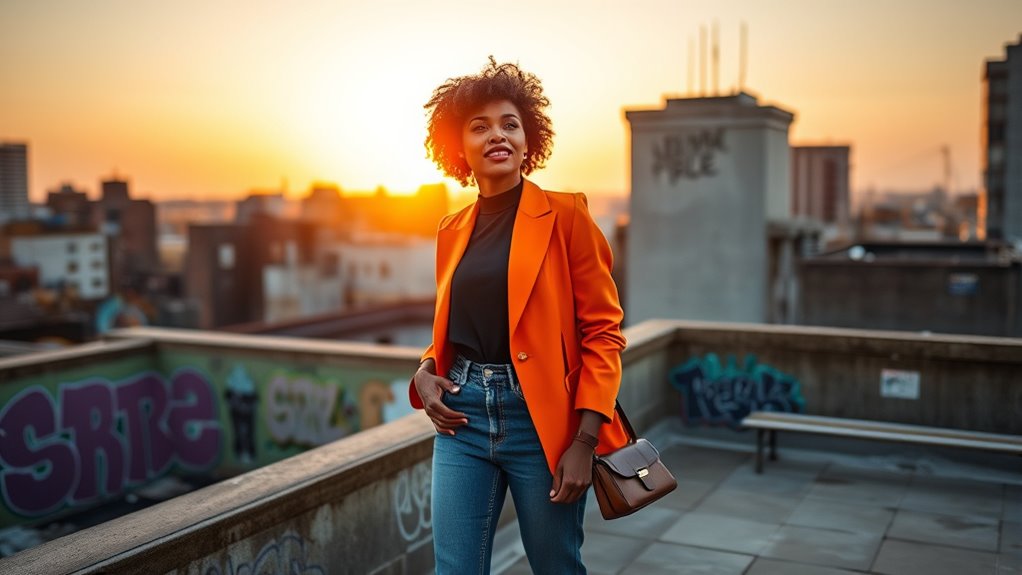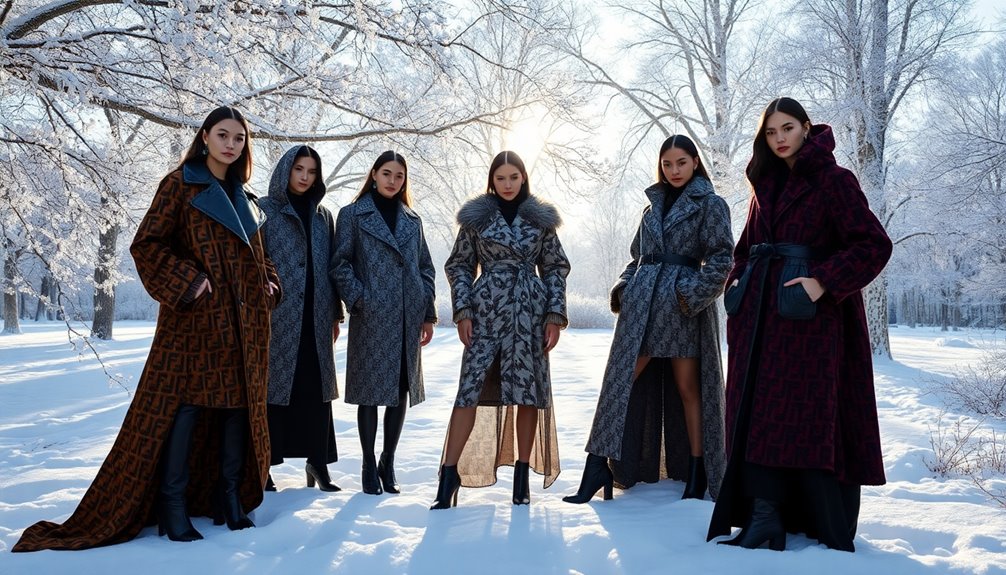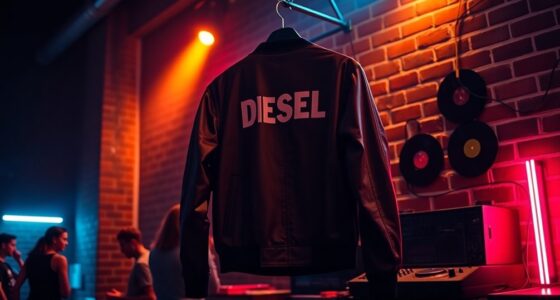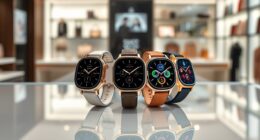Fashion and feminism go hand in hand as tools for empowerment. Your clothing choices can challenge societal norms, express your identity, and advocate for equality. From iconic protest styles like slogans and symbols to embracing diversity and gender-fluid looks, your style becomes a statement of resistance and solidarity. Social media amplifies these messages, making activism more accessible. Keep exploring to discover how your personal style can become a powerful act of empowerment and change.
Key Takeaways
- Fashion serves as a tool for self-expression, resistance, and claiming space, empowering individuals to challenge societal norms.
- Feminist fashion uses symbols, slogans, and inclusive designs to promote diversity, body positivity, and social activism.
- Clothing choices reflect activism, with examples like protest accessories and campaigns highlighting issues like reproductive rights.
- Gender-neutral and inclusive fashion challenge traditional binaries, fostering self-empowerment and authentic identity.
- Industry innovations focus on sustainability, representation, and ethical practices, supporting empowerment through socially conscious style.
The Evolution of Feminist Fashion Movements
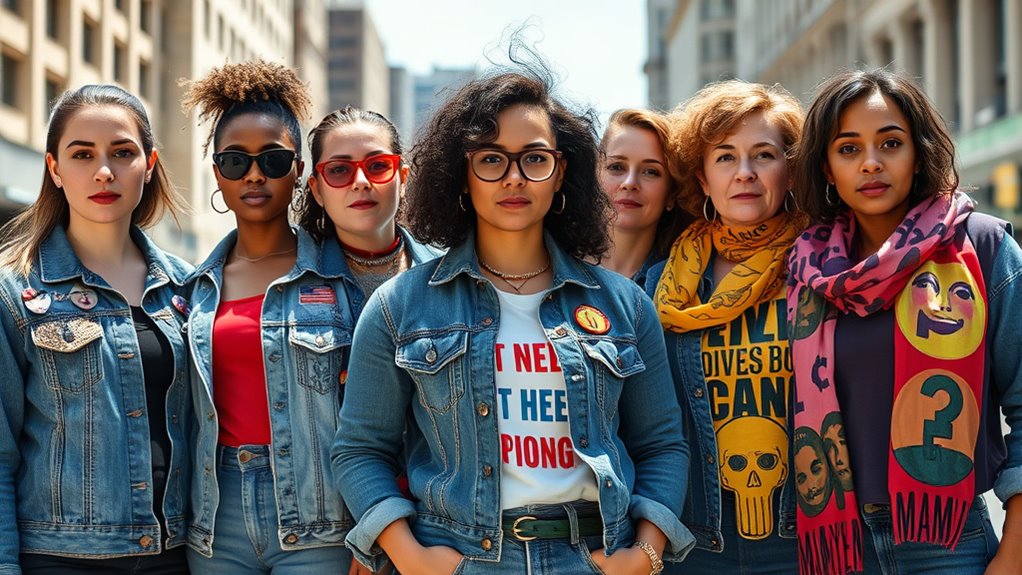
The evolution of feminist fashion movements reflects how women have used clothing as a powerful form of self-expression and resistance. Over time, women challenged societal norms by adopting styles that defied traditional expectations. During the suffrage movement, practical attire like bloomers symbolized independence and a break from restrictive garments. In the 1960s and 70s, bold colors, miniskirts, and rebellious styles showcased a desire for freedom and gender equality. Modern feminist fashion continues this legacy, emphasizing comfort, body positivity, and individuality. You might choose clothing that highlights your identity or pushes boundaries, making a statement without words. Throughout history, fashion has served as a subtle yet impactful tool for women to claim space, assert their rights, and redefine femininity on their own terms. Embracing diverse styles that promote body positivity and inclusivity empowers women to challenge traditional beauty standards and express authentic selves. Additionally, the use of fashion as activism has become increasingly prominent in contemporary movements, highlighting how style can directly influence societal perceptions and promote change. Recognizing the influence of health benefits of various natural products also encourages women to adopt more holistic approaches to self-care and empowerment through style and wellness. Furthermore, understanding the financial impact of the entertainment industry reveals how cultural shifts in fashion can influence societal attitudes and economic opportunities for women.
Iconic Moments: Fashion as a Protest Tool
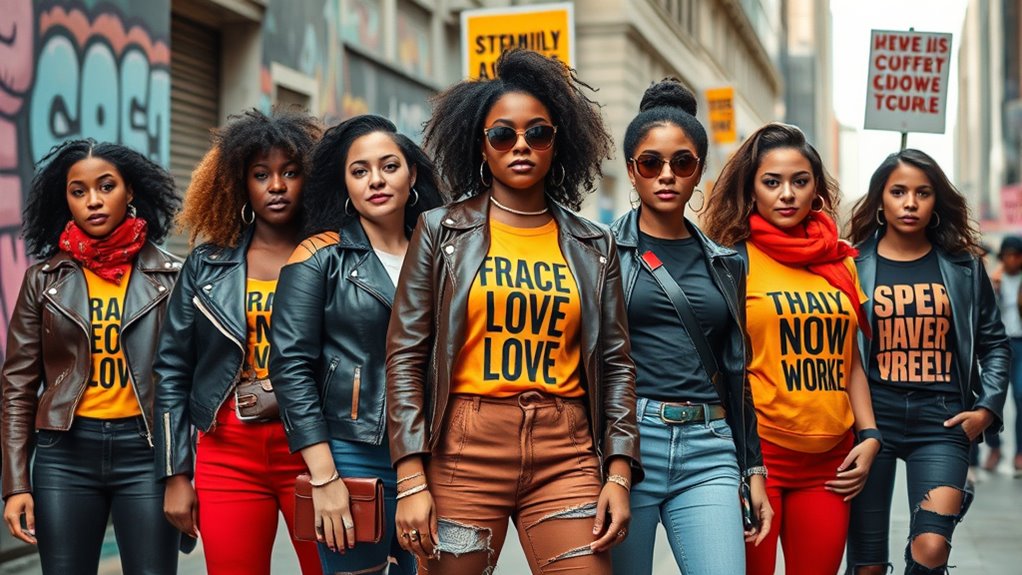
Throughout history, fashion has served as a powerful tool for protest, allowing women to make bold statements without uttering a word. Think of the iconic pink pussy hats at the Women’s March, which symbolized solidarity and resistance. Or consider the 1968 punk movement, where ripped clothing and safety pins challenged societal norms and expressed rebellion. These moments show how clothing can transcend style, becoming a visual declaration of dissent. Fashion choices often carry messages that resonate beyond aesthetics, capturing public attention and sparking conversations. By wearing specific garments or accessories, you can participate in a collective voice that challenges oppression, promotes change, and celebrates empowerment. These iconic moments demonstrate that what you wear can be as powerful as what you say. Additionally, clothing as a form of activism has historically been used to amplify marginalized voices and foster social change, emphasizing the role of cultural symbolism in shaping social movements. Recognizing the emotional impact of fashion helps us understand its influence in inspiring collective action and societal transformation. The sustainable fashion movement further underscores how fashion can promote ethical values and environmental responsibility, extending its role beyond aesthetics into social justice. Incorporating fashion in social movements can also inspire future generations to view clothing as a tool for positive change.
Slogans and Symbols: Making Statements With Clothing
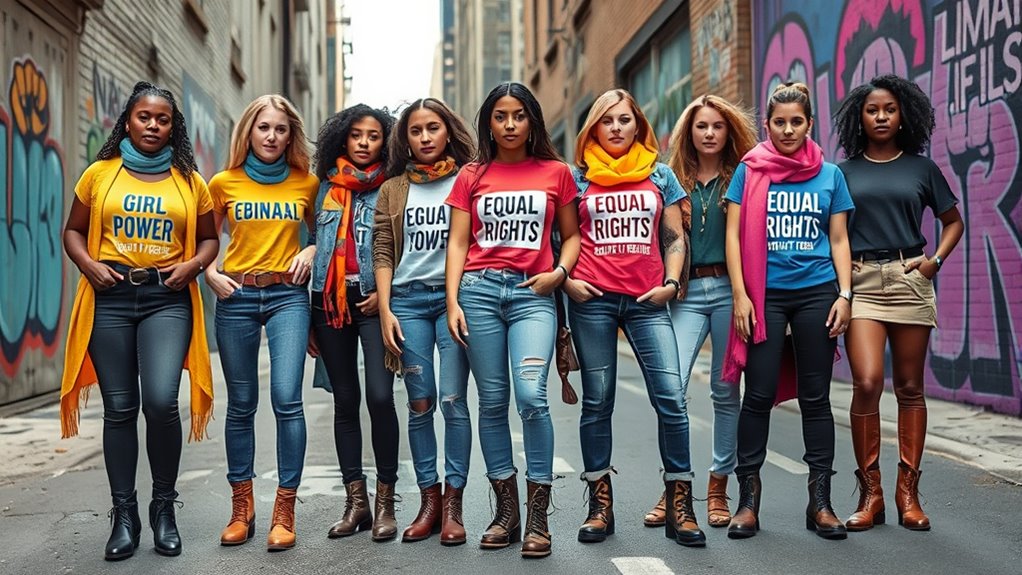
Fashion continues to be a potent platform for making bold statements, especially through slogans and symbols that communicate powerful messages instantly. When you wear clothing with a slogan like “Nevertheless, She Persisted” or a symbol such as the female sign, you’re not just dressing—you’re asserting your beliefs and values. These visual cues become conversation starters and rallying cries for feminist causes. Bold prints, catchy phrases, and recognizable symbols help you express solidarity, challenge stereotypes, and demand change without words. By choosing such pieces, you actively participate in shaping cultural conversations around gender equality and empowerment. Your clothing becomes a wearable protest, turning everyday fashion into a statement of strength and resistance that others can’t ignore. Incorporating symbols like the female sign into your wardrobe can be a subtle yet powerful way to align your style with feminist ideals. Engaging in community-based fashion projects can further amplify your message and showcase individual expression. Cultivating a creative practice in your fashion choices—such as custom designs or DIY accessories—can further amplify your message and showcase individual expression. Additionally, embracing dynamic communication exercises can help you confidently articulate the significance behind your clothing choices and inspire others to do the same. Exploring environmental considerations in fashion can also reinforce your commitment to sustainability and ethical practices within your activism.
Celebrating Diversity and Body Positivity
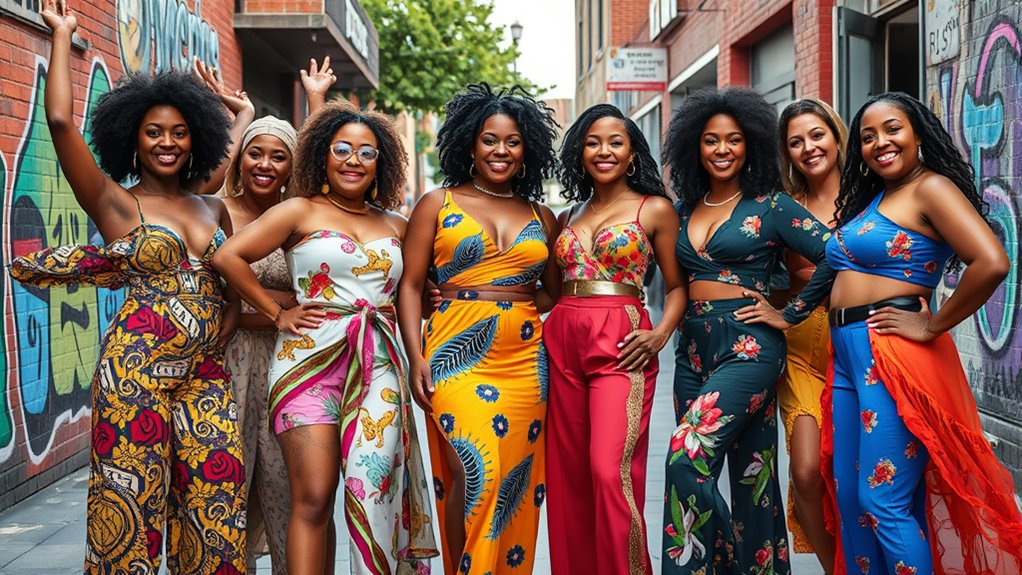
Celebrating diversity and body positivity has become a powerful movement within fashion, encouraging you to embrace all shapes, sizes, and backgrounds. It’s about rejecting narrow beauty standards and recognizing that beauty comes in many forms. As you see brands featuring models of different ethnicities, ages, and body types, you’re reminded that fashion should reflect real life. This movement empowers you to feel confident in your skin, regardless of societal expectations. You’re encouraged to choose clothing that makes you feel comfortable and authentic, not just trendy or mainstream. Celebrating diversity fosters inclusivity and challenges stereotypes, helping you build a positive relationship with your body. Recognizing the unique features of different dog breeds, such as the Black Golden Retriever’s distinctive coat, can inspire a broader appreciation for diversity. Understanding the security system options available can further empower you to create a safe and welcoming environment for everyone. Additionally, being aware of ear wax odor and other subtle indicators can help you stay attentive to health and well-being, reflecting a holistic approach to self-care. Embracing body positivity also encourages self-love and acceptance, and exploring the square footage of tiny houses can inspire similar appreciation for space and design. Creating a home that fits your needs and personality is a form of self-expression and empowerment. Ultimately, it’s about feeling proud of who you are and expressing that pride through style.
Gender-Fluid Fashion and Breaking Norms
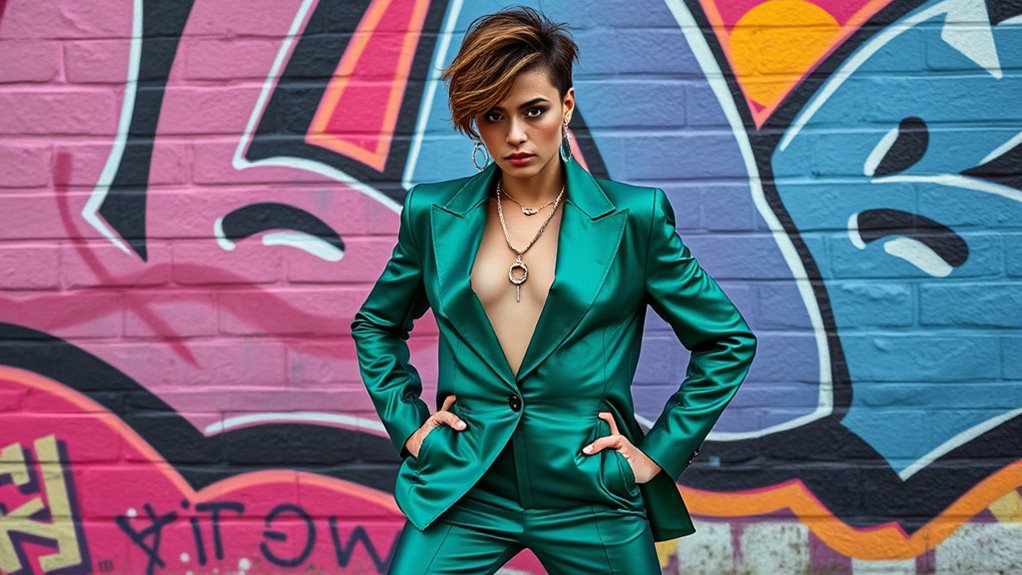
Gender-fluid fashion is challenging traditional ideas of what clothing should say about your identity. It blurs the lines between male and female styles, encouraging you to express yourself freely without conforming to societal expectations. When you choose gender-neutral or non-binary clothing, you’re breaking down outdated norms and redefining what fashion can represent. This movement promotes individuality and inclusivity, allowing you to wear what feels authentic rather than fitting into prescribed categories. By embracing gender-fluid fashion, you send a powerful message: your identity isn’t limited by gender. You take control of your style, challenge stereotypes, and contribute to a broader cultural shift toward acceptance and diversity. It’s about making fashion a tool for empowerment and self-expression.
Influential Designers Supporting Feminist Causes
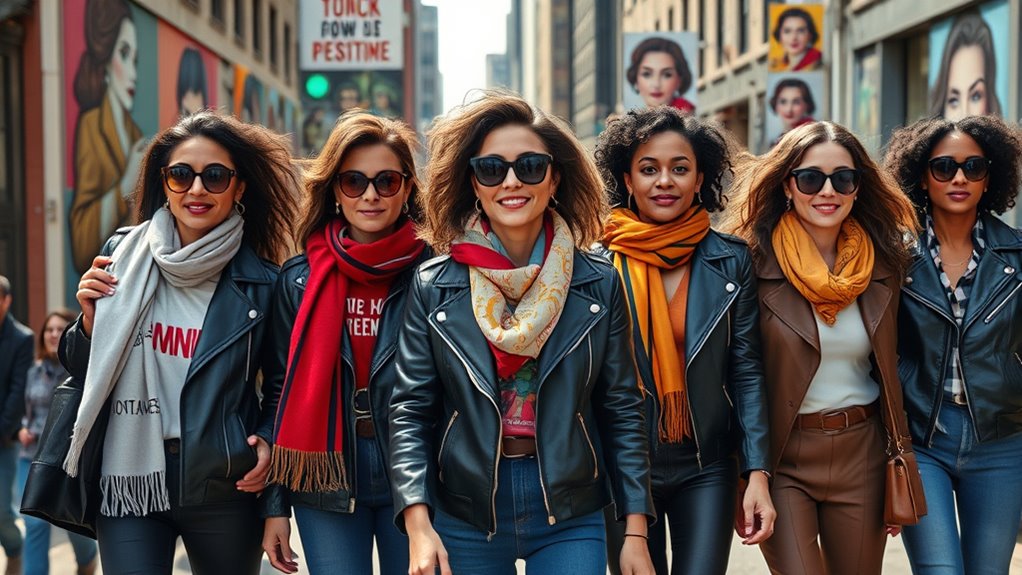
Many influential designers actively support feminist causes through their work and initiatives. They celebrate gender equality, promote women’s rights, and create campaigns that drive social change. These efforts show how fashion can be a powerful platform for advocating equality and empowerment. Furthermore, some designers incorporate kindness and compassion into their brand values, inspiring a more empathetic approach to fashion and social activism. Additionally, embracing inclusive fashion helps challenge traditional beauty standards and promotes diversity within the industry. Recognizing the spiritual significance of the number 7, some brands incorporate themes of completeness and renewal into their collections to deepen their message of empowerment.
Celebrating Gender Equality Initiatives
Have you noticed how some of the most influential fashion designers are using their platforms to promote feminism? They actively support gender equality initiatives, inspiring change through their brands and actions. These designers often partner with organizations that champion women’s rights, raise awareness with powerful campaigns, and create collections that celebrate diversity. Their efforts extend beyond clothing, influencing industry standards and societal attitudes. You’ll find them:
- Launching gender-neutral lines to challenge stereotypes
- Donating proceeds to charities empowering women and girls
- Using runway shows to spotlight gender equality issues
Designers Promoting Women’s Rights
Influential designers are leveraging their fame to champion women’s rights, turning their platforms into tools for social change. They incorporate feminist messages into their collections, using bold slogans and empowering symbols to spark conversations. Some designers partner with women’s rights organizations, donating proceeds or raising awareness through runway shows. Others create collections that highlight issues like gender inequality or violence against women, making a statement with every piece. By doing so, they challenge societal norms and inspire action among their audiences. Their influence extends beyond fashion, shaping cultural attitudes and fostering solidarity. These designers understand that style can be a powerful form of activism, giving women a voice and promoting empowerment through every stitch and seam. Additionally, some designers utilize their influence to promote well-being tips, encouraging women to embrace self-care and resilience as part of their empowerment journey. Recognizing the importance of social impact in fashion, these creators aim to inspire positive change within and outside the industry, often incorporating sustainable and ethical practices to align their activism with environmental responsibility. The use of ethical sourcing further emphasizes their commitment to social justice.
Fashion Campaigns for Change
How do designers turn their runway shows and advertising campaigns into powerful tools for feminist advocacy? They use bold visuals, inclusive messaging, and collaborations with activists to highlight gender equality. By featuring diverse models and challenging traditional beauty standards, they send a clear message of empowerment. Campaigns often spotlight issues like reproductive rights, workplace equality, and body positivity, turning fashion into a platform for change. Influential designers leverage their reach to spark conversations and inspire action. Additionally, some incorporate diverse designs to further promote inclusivity and challenge conventional norms, emphasizing the importance of cultural heritage and upbringing in shaping modern feminist fashion initiatives.
Social Media’s Role in Fashion Activism
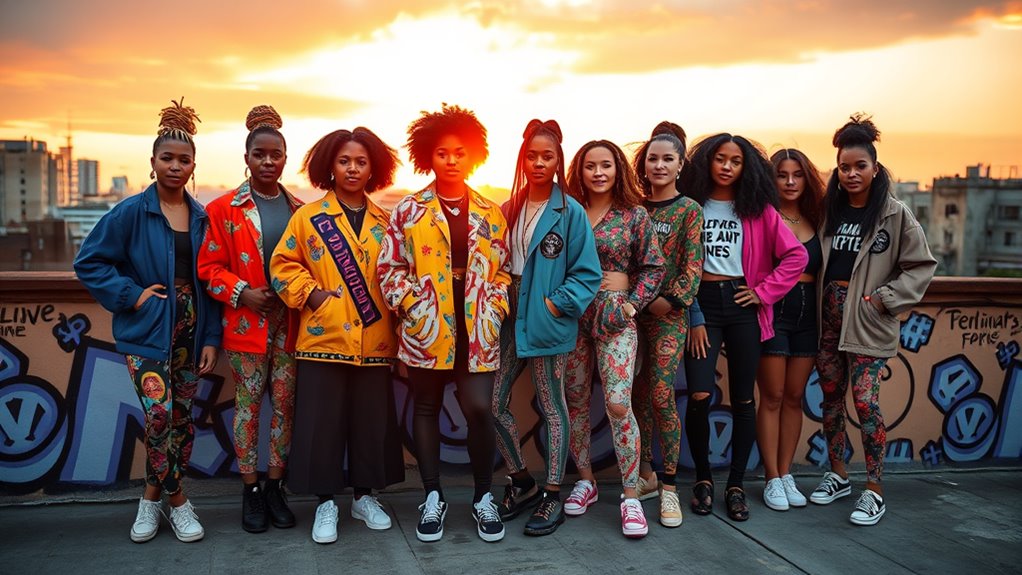
Social media has revolutionized fashion activism by providing a powerful platform for voices that were previously marginalized or unheard. You can now share your perspectives, challenge industry standards, and highlight issues like body positivity, diversity, and ethical practices instantly. Hashtags like #FashionForChange and #WearYourValues create communities that amplify your message and inspire collective action. Influencers and everyday users alike can spotlight brands that align with feminist principles, press for accountability, and celebrate inclusive representation. Social media also enables real-time engagement, making activism more accessible and immediate. You become part of a global movement, influencing change not just through words but through visual storytelling and shared experiences. This shift empowers you to make an impact in shaping a more equitable, conscious fashion industry.
Empowerment Through Personal Style Choices

Your personal style is a powerful tool for expressing your values and asserting your identity. When you choose your outfits intentionally, you communicate confidence, individuality, and even solidarity. Clothing can challenge stereotypes or showcase your support for causes you care about. By selecting pieces that resonate with your beliefs, you reinforce your empowerment and authenticity.
Your style expresses your values, confidence, and support for causes you believe in.
Consider how your style:
- Reflects your stance on gender norms and expectations
- Celebrates cultural heritage or personal history
- Sends a message of solidarity with social movements
Your wardrobe becomes a canvas for activism, allowing you to make statements without words. Every choice enhances your sense of control and confidence, empowering you to stand tall and express who you truly are.
Collaborations and Campaigns Promoting Gender Equality
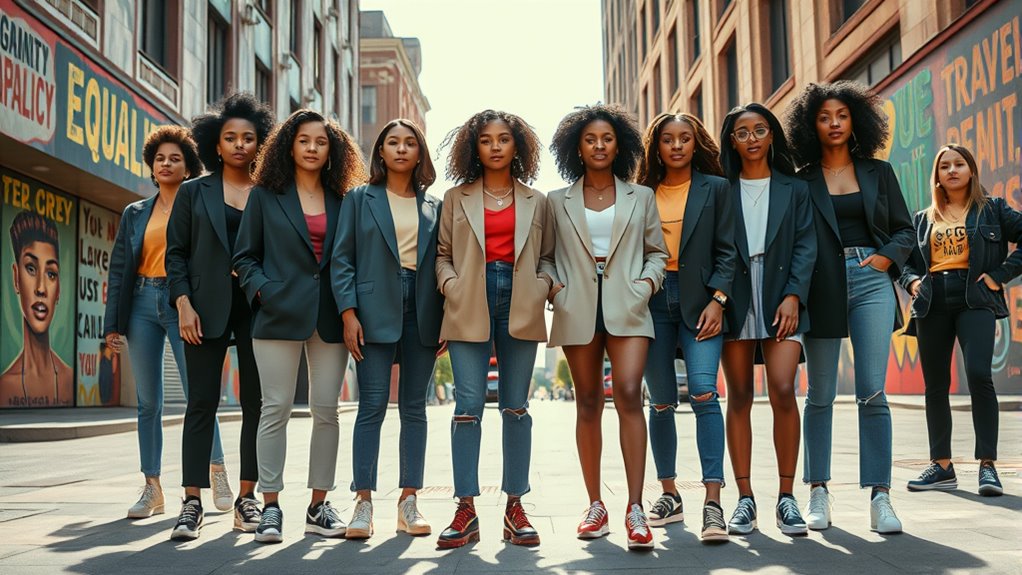
Have you noticed how brands and designers are increasingly partnering with activists and advocacy groups to promote gender equality? These collaborations often feature powerful messaging and bold visuals that challenge stereotypes and amplify marginalized voices. Campaigns like Nike’s “Dream Crazier” or UN Women’s initiatives use fashion as a platform to spark conversations and inspire change. You might see limited-edition collections that highlight women’s achievements or promote gender-inclusive designs. These efforts not only raise awareness but also support causes through proceeds or visibility. When you engage with these campaigns, you’re part of a movement that pushes for a more equitable society. They demonstrate how fashion can serve as a tool for activism and empowerment, making gender equality a visible, celebrated goal.
The Future of Feminist Fashion and Self-Expression
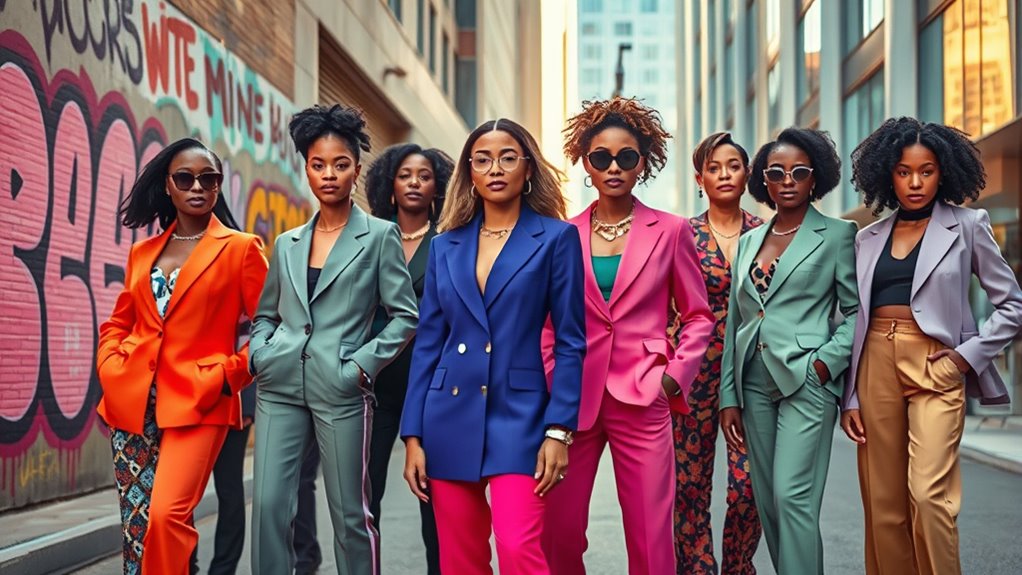
As feminist collaborations gain momentum, they are shaping a future where personal style becomes a form of activism and self-assertion. You’ll see more brands embracing diverse representations, challenging traditional beauty standards, and encouraging authentic self-expression. Future feminist fashion will empower you to use clothing as a statement of identity, resistance, and solidarity. Expect innovations like sustainable materials, inclusive sizing, and gender-neutral designs that reflect evolving values. You’ll also witness:
Feminist fashion transforms personal style into activism through diversity, sustainability, and inclusive design.
- Increased visibility for marginalized voices in fashion campaigns
- The rise of DIY and community-driven fashion movements
- Digital platforms amplifying individual stories and styles
This shift will make your wardrobe a powerful tool for advocacy, helping you communicate your beliefs while celebrating your unique identity.
Frequently Asked Questions
How Can Fashion Promote Genuine Feminist Values Beyond Trends?
You can promote genuine feminist values through fashion by choosing clothing that challenges stereotypes and supports equality. Use your style to express solidarity with feminist causes, wear brands that prioritize ethical practices, and advocate for diverse representation. By consciously selecting pieces that reflect your beliefs, you demonstrate empowerment beyond fleeting trends, inspiring others to see fashion as a tool for social change and reinforcing your commitment to feminist principles.
What Are the Risks of Using Fashion for Feminist Activism?
Like walking a tightrope over a stormy sea, using fashion for feminist activism carries risks. You might face backlash or superficial support that dilutes your message. Trends can shift quickly, turning your powerful statement into fleeting spectacle. If you rely solely on style, it risks becoming surface-level, missing the deeper fight for equality. You must balance visibility with authenticity, ensuring your message remains rooted even amid changing fashion tides.
How Do Cultural Differences Influence Feminist Fashion Movements Globally?
You see that cultural differences shape how feminist fashion movements unfold worldwide. In some cultures, traditional clothing symbolizes resistance and pride, while others may view revealing styles as empowering. You need to recognize these diverse perspectives to avoid misunderstandings or offending local customs. Embracing cultural nuances allows you to support feminist activism authentically, respecting local traditions and fostering global solidarity through fashion that resonates with different identities and values.
Can Fashion Truly Challenge Deep-Seated Gender Stereotypes?
You wonder if fashion can really break barriers and challenge deep-rooted gender stereotypes. The answer is yes, when you wear what feels authentic and defies traditional norms, you can spark conversations and inspire change. Fashion’s boldness can challenge stereotypes by showcasing diversity, redefining roles, and encouraging self-expression. Your choices can challenge conventions, creating a cultural current that pushes boundaries and promotes a more inclusive, empowered perspective on gender identity.
How Does Economic Status Affect Access to Feminist Fashion and Activism?
You might notice that your economic status impacts your access to feminist fashion and activism. If you have more resources, you can afford to buy empowering clothing, attend events, or support brands aligned with your values. Conversely, limited finances may restrict participation, making activism and style choices harder to access. Your economic position influences your ability to express and engage with feminist ideas through fashion, shaping your activism journey.
Conclusion
You’ve seen how fashion can be a powerful tool for empowerment and change. By embracing diverse styles, challenging norms, and standing up with bold statements, you can make your voice heard without saying a word. Remember, fashion is your armor and expression—use it wisely to break barriers and inspire others. When it comes to feminism and style, it’s clear that you hold the power to turn heads and open minds.
